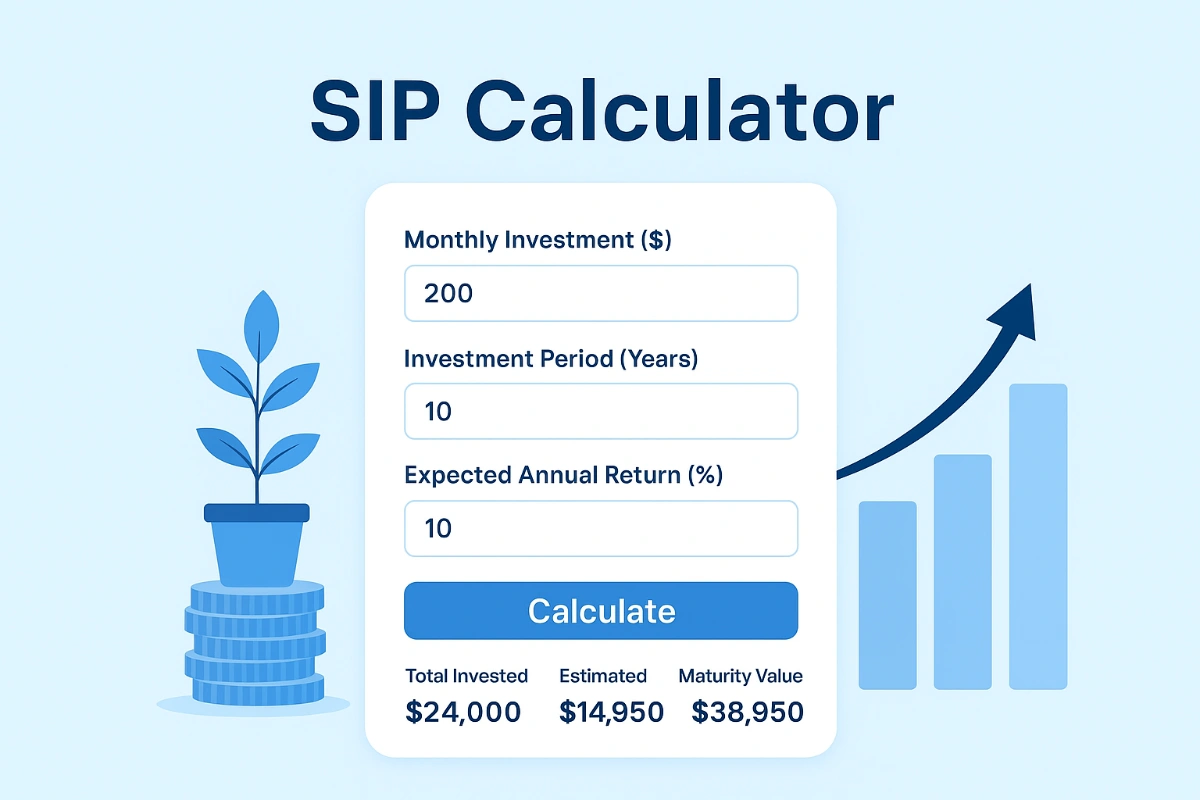SIP Calculator
SIP Calculator: Your Smart Guide to Building Wealth

What is a SIP?
A Systematic Investment Plan (SIP) is a disciplined way to invest a fixed sum at regular intervals into a mutual fund or other pooled investment. Instead of investing a lump sum, you contribute small amounts each month or quarter. Over time, these regular contributions purchase fund units at varying market prices, averaging your purchase cost and reducing the impact of short term volatility.
Why SIPs work for steady wealth creation
SIPs remove the need to time the market. They convert saving into an automated habit and use the power of compounding to grow wealth. The three key drivers of long term SIP returns are the monthly contribution, the investment horizon and the net return after fees and taxes. Small disciplined contributions over long horizons typically beat erratic market timing attempts by most investors.
What a SIP calculator shows
A SIP calculator translates inputs into a clear projection. Typical outputs include the total amount invested, the estimated final (nominal) value, the growth portion and an inflation adjusted value. Good calculators let you model step-up in contributions, inflation, annualized return assumptions and provide year-by-year balances so you can track milestones.
How the calculation works (no heavy math)
Every monthly contribution grows for the remaining months in the plan. The calculator effectively sums the future value of each monthly contribution using a monthly equivalent return derived from an annual rate. If you introduce a step-up, the calculator increases the monthly amount each year before computing that year’s contributions. If you add inflation, the final nominal result is converted into today’s purchasing power.
Practical example
If you invest $200 per month for 10 years at an expected annual return of 10 percent, you will see the power of compounding. Your invested amount would be $24,000 while the estimated maturity value is approximately $38,950. The difference reflects the returns earned during the investment horizon.
Inputs you should choose deliberately
- Monthly amount: The habit variable. Choose a sustainable figure so contributions continue even under stress.
- Time horizon: Longer horizons amplify compounding. Prefer horizons of 7–10+ years for equity-heavy plans.
- Expected annual return: Use realistic ranges. For global equities, 6–9 percent long term is a reasonable working assumption for many first world investors. For conservative allocations use lower figures.
- Step-up percent: Plan small annual increases to match salary growth and inflation.
- Inflation: Convert nominal results to real purchasing power to avoid overconfidence.
Common pitfalls and how to avoid them
Expectations that depend on precise returns are risky. Use scenario analysis: conservative, base case, and optimistic assumptions. Account for fees and taxes as they reduce net returns. Avoid confusing nominal values with real purchasing power. Finally, do not pause SIPs for short term noise; maintain an emergency fund instead.
Manager-level tips
- Automate contributions shortly after payday to preserve discipline.
- Prefer low-cost index funds for the core allocation and complement them with high quality fixed income where appropriate.
- Rebalance periodically to maintain target risk exposure.
- Increase contributions when income rises. Small annual step-ups compound meaningfully.
- Measure progress using year-by-year balances rather than only a final headline number.
How to use this page
Scroll to the embedded calculator below. Try different monthly amounts, horizons and return assumptions. Use the step-up feature to model raises and check the inflation-adjusted column to see real purchasing power at each milestone.
SIP Calculator
Estimate your returns with step-up and inflation adjustment.
| Year | Total invested | Year end value | Gains | Inflation adjusted |
|---|
Final notes
A SIP calculator is a planning assistant. It cannot promise returns, but it helps you convert intentions into concrete plans. Use conservative assumptions for planning and a base case for motivation. Automate contributions, increase them with pay rises, and keep emergency savings separate so your plan doesn’t pause. Revisit your plan annually or when life events change your financial picture.
If you want, I can provide a WordPress shortcode or an Elementor widget wrapper for this single-file calculator, or generate a downloadable PNG summary card for social sharing. Tell me which format you prefer and I will prepare it.
